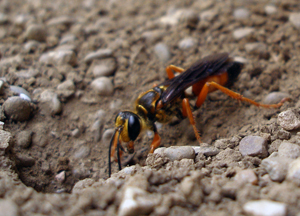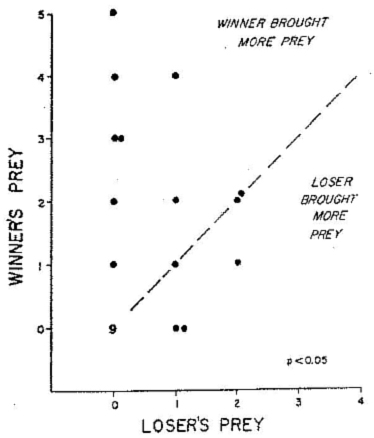
Sphex ichneumoneus, the great golden digger wasp, about to enter her burrow. |
 A few weeks ago, I noticed some alarmingly large insects that resembled wasps outside the front entrance of the biology building at Kenyon College. They would fly a few centimeters above the sandy gravel, no doubt surveying the best landing spot. Only a handful of these solitary wasps were here hovering over at least a dozen wasp-diameter holes in the loamy soils under this protected overhang. Suddenly, one landed and disappeared into her burrow. Ah! Digger wasps! I had read about them but never before observed them in the wild. Well, as wild as a well-manicured college campus is in the relative calm of summer. The wasps were a mixture of brilliant orange contrasted with a deep black color. Almost blue iridescent wings fluttered periodically as they danced around the burrows. After consulting available guides and experts in the natural sciences division at Kenyon, it was confirmed these are indeed the great golden digger wasps (Sphex ichneumoneus). These beautiful solitary wasps emerge in the summer and spend about 6 weeks building multiple burrows that they then provision with paralyzed katydids. When the female - the males do not assist in burrow building or provisioning - is satisfied with her stash, she lays a single egg and closes the burrow
A few weeks ago, I noticed some alarmingly large insects that resembled wasps outside the front entrance of the biology building at Kenyon College. They would fly a few centimeters above the sandy gravel, no doubt surveying the best landing spot. Only a handful of these solitary wasps were here hovering over at least a dozen wasp-diameter holes in the loamy soils under this protected overhang. Suddenly, one landed and disappeared into her burrow. Ah! Digger wasps! I had read about them but never before observed them in the wild. Well, as wild as a well-manicured college campus is in the relative calm of summer. The wasps were a mixture of brilliant orange contrasted with a deep black color. Almost blue iridescent wings fluttered periodically as they danced around the burrows. After consulting available guides and experts in the natural sciences division at Kenyon, it was confirmed these are indeed the great golden digger wasps (Sphex ichneumoneus). These beautiful solitary wasps emerge in the summer and spend about 6 weeks building multiple burrows that they then provision with paralyzed katydids. When the female - the males do not assist in burrow building or provisioning - is satisfied with her stash, she lays a single egg and closes the burrow, commonly completing this process 10 times before her short adult life is over. This species is common to much of the United States, so it's not a surprise to find them here in Ohio.

The sheltered gravel/sand area outside Higley Hall at Kenyon College is the perfect burrow building habitat for the great golden digger wasp. |
My usual curiosity of the natural world doesn't typically extend beyond plants, but my interest was piqued. When searching for information on species I have not encountered before, I am often disappointed. Indeed, the great many species out there have been described in full maybe once - the original description - and mentioned a handful of other times in other publications as simply being an associate of other species. It's unusual to find such a detailed account of the life history of a single species, but I was pleasantly surprised with
Sphex ichneumoneus. This species and its relatives have been observed in great detail and their behavior has made our species ponder the nature of philosophical fallacies and free will. What a creature!
Investment and return
Over six breeding seasons in the 1970s,
H. Jane Brockmann recorded data of wasp behavior from three sites. Typically, each female will work on her own to dig and provision her burrow, but sometimes two females will begin provisioning the same nest in 5-15% of cases. The interloper takes advantage of the other wasp's spent investment and the two will be bringing katydids into the same nest. But because they spend most of their time away from the nest seeking new prey, it is only a coincidence if the two meet and fight over the nest. Fights last between 2 and 16 minutes and often the loser would leave and never return. Because of this one-on-one interaction where both insects have varying degrees of past interest (their future interests would be identical), the data can be thought of in simple game theory mechanics. The founding wasp took the time to dig the burrow and begin provisioning it, while the joiner risked being discovered and the subsequent fight to cheat and not build her own burrow. When faced with a fight, however, each has the same prize and motivation: a well-provisioned nest is worth fighting for, saving the winner days more of additional digging and hunting to lay a single egg.
The "sunk cost fallacy," or Concorde fallacy, so named because the British and
American French governments continued to fund the faster trans-Atlantic
Concorde flights even when there was no longer any economic incentive to do so, refers to decisions based on past investment because of loss aversion instead of on the rational potential future gains. Brockmann, along with
Richard Dawkins, asked the question, "Do digger wasps commit the Concorde fallacy?" in their 1980 publication. The available evidence suggested that the wasp with the least prior investment in a burrow would give up first in a fight and abandon her effort. This result was not skewed by size advantage, which wasp visited the burrow most recently, or whether the winner was the founder or the joiner. Put plainly,
the winner was usually the one who brought the most katydids to the burrow. As Brockmann and Dawkins say, "It is hard to resist the suspicion that the wasps are behaving as if following the Concorde fallacy." But are they?

Number of katydids each fight participant brought. Nine fights were over empty burrows. From Dawkins & Brockmann, 1980.
|
Further, the fight
length was strongly dependent on how many katydids the loser brought. Falling into the Concorde fallacy, you might conclude that the loser will fight more vigorously because of greater prior investment in the burrow and less vigorously for those she has barely begun to provision. The losing wasp appears to rationalize: "Fight only as long as is proportional to your individual investment in this burrow." This case study informed the ongoing discussion of whether we humans consider such strategies to be "good" in our assessment relative to their evolutionary stability. The Concordian strategy versus the strict economist (fight based on potential future gain) is fully revealed here in this brilliant case study.
Free will
Just one more quick interesting note about these creatures. In Daniel Dennett's book
Elbow Room
, he reproduces an account by Woolridge in 1963 about the deterministic behavior of
Sphex ichneumoneus. Woolridge watched the wasps return to their burrows with katydids, leaving them just outside while they went inside to inspect. Normally, the wasp is inside for a few seconds, then reemerges and drags the paralyzed katydid backward down into the burrow. He decided to alter the pattern to see if the wasp's behavior changed. When the wasp entered the burrow, Woolridge would subtly move the katydid a few inches from the burrow threshold. The wasp reemerged to find he prey moved, dragged it back to the threshold, then dove back into the burrow alone to inspect again. Woolridge writes, "On one occasion this procedure was repeated forty times, always with the same result." The wasp appears to be an unwilling participant in a free will experiment. She is not a free agent, but instead is driven by environmental cues: once a katydid is near the threshold, I must inspect the burrow and only then can I bring it inside. This property, an apparent lack of free will, was even given the name
sphexishness. Dennett notes that publications on free will are rife with fears of sphexishness. Call it genetic determinism or a behavioral loop. Perhaps, though, we're all a little sphexish.
And what of the wasps?
I know their short adult lives will be over soon, but I've enjoyed viewing them through the window these past few weeks. Apparently, though, their lives were meant to be shorter than usual. I walked out the door the other day and noted the acrid smell of pesticides on the air. It got stronger as I approached the burrows and each hole was wet, as if it had been sprayed.
Sphex ichneumoneus is a solitary wasp that is not inclined to sting anything but katydids. If you approach them or their burrows, they fly away, bothering no one. I was told our department administrative assistant tried to fill the holes in one day and I suspect she alerted the maintenance department to their presence, thus leading to their demise. Perhaps if people took the time to find out more about the supposed threat before eradicating it, they might change their minds about the course of action. That at least one good motivation for effective science education.
DAWKINS, R., & BROCKMANN, H. (1980). Do digger wasps commit the concorde fallacy? Animal Behaviour, 28 (3), 892-896 DOI: 10.1016/S0003-3472(80)80149-7



I suspect the administrative assistant's behavior may have been an example of sphexishness. Have you considered having her office moved a few yards to the right next summer?
ReplyDeleteTony: Interesting point. Atavistic fear of stinging, biting, creepy crawlies does carry some flavor of sphexishness. The most sphexish quality would then be avoidance. Going out of your way to fill in their burrows and make the effort to alert maintenance to their presence is retaliation for the critters being so gosh-darn large and scary looking. Her office isn't even near the nest, but I suppose she saw them when coming to work as they are right near the door.
ReplyDeleteGood thought to ponder. Dennett's book continues to the discussion of sphexishness in humans, but I admit I haven't read more than the google books preview section on this particular species. Cheers!
I do not think the American government invested on the Concorde at all since it was a Anglo-French project. So the American government did not commit the Concorde fallacy, at least in that instance :-)
ReplyDeleteJ.M.C., Goodness! How did I miss that? Thanks for catching my error.
ReplyDelete